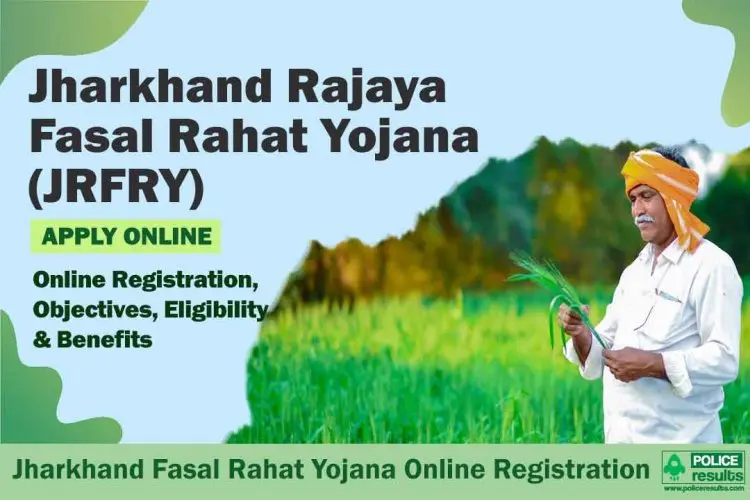Online Application, Application Form for the Jharkhand Crop Relief Scheme
The state government of Jharkhand will forgive the farmer's loan as part of this program. The government spent 2000 crore rupees

Online Application, Application Form for the Jharkhand Crop Relief Scheme
The state government of Jharkhand will forgive the farmer's loan as part of this program. The government spent 2000 crore rupees
The Central Government and the State Governments are working hard to boost farmer income. Farmers are sometimes forced to suffer as a result of natural disasters. The Jharkhand Government has launched the Jharkhand Fasal Rahat Yojana with this in mind. In place of the Pradhan Mantri Fasal Bima Yojana, the Jharkhand government has launched the Jharkhand Fasal Rahat Yojana. Here in this post, we will discuss everything about What is the Jharkhand Fasal Rahat Yojana, what are its benefits, characteristics, eligibility, required papers, application procedure, and so on?
In this Jharkhand Fasal Rahat Yojana, the state govt. will forgive the farmer's loan. The government has given up Rs 2000 crore for this. A website for loan forgiveness will be created by the government. This is where all of the farmers' data will be collected. Along with the Jharkhand Fasal Rahat Yojana 2022, the government plans to forgive agricultural debts up to Rs 50000/- for farmers in the state. Farmers will benefit from both programs concurrently beginning January 1, 2022. From January 1, 2022, the state's Chief Minister, Shri Hemant Soren, will introduce this plan. Jharkhand Kisan Karz Mafi Yojana is another name for it.
If you wish to apply for the Jharkhand Crop Relief Scheme, you'll have to wait a while. So yet, the administration has just announced this program. The government will soon announce the application process for the Jharkhand Fasal Rahat Yojana. We will notify you via this page as soon as the application procedure for the Jharkhand Crop Relief Scheme is launched by the government. Please continue to read our content.
It is a compensation scheme aimed at providing security cover to Jharkhand farmers in case of crop damage due to natural calamity. It will cover both land-owning and landless farmers. The Department of Agriculture, Animal Husbandry and Co-operative will be the implementing agency and it will work in association with a project management unit, which will be a consultancy firm that will take care of technical requirements. “Food safety, crop diversification, rapid development in agriculture, and paving the way for competition,” are among the aims of the scheme. It is not an insurance scheme where premiums are paid.
Jharkhand Fasal Rahat Yojana Required Documents 2022
- The farmer must be a resident of Jharkhand on a permanent basis.
- Farmers who do not have insurance will be eligible for this program.
- Aadhar Card
- Ration card
- farmer id card
- Bank account statement
- Address proof
- Farm account number / Khasra number paper
- passport size photograph
- phone number
- income certificate
Jharkhand Fasal Rahat Yojana Eligibility Criteria 2022
- A permanent resident of Jharkhand is required for the application.
- Farmers who are not currently enrolled in an insurance program will be eligible for this program.
Jharkhand Fasal Rahat Yojana Benefits
- Farmers will receive financial help under the Jharkhand Fasal Rahat Yojana if their crops are lost due to natural disasters.
- The insurance firm would compensate the registered farmers for any losses under this arrangement.
- Farmers' incomes will rise as a result of the Jharkhand Fasal Rahat Yojana, and they will become self-sufficient.
- The government has allocated aside Rs 100 crore for the execution of the Jharkhand Fasal Rahat Yojana.
- The premium amount would be paid by farmers who are registered under the Jharkhand Fasal Rahat Yojana.
There are around 38 lakh farmers cultivating 38 lakh hectares of land in Jharkhand. The government says that among them around 25 lakh farmers are small or marginal landholders. This year, adequate rainfall occurred in Jharkhand, however, in the last three years (2017-19), the average rainfall in the monsoon season was much less and stood at 13%, -27.8%, -20.9%’ respectively.
Irregular monsoon has affected the Kharif sowing season and as Jharkhand is mostly a single crop (paddy) state, the scheme will primarily target this group of farmers. Also, drought has been a concern in the state: In 2018, 129 blocks were drought-affected while in 2019 the number was 107.
Every year a large amount is paid as a premium to the insurance companies. Jharkhand paid a total of Rs 512.55 crore in the last three years while the compensation claim settlement was only Rs 82.86 crore, which was only 16 percent of the total premium.
The number of farmers who benefited as compared to the actual cover is also hugely disproportionate. In the last three years, out of a total of 33.79 lakh registered farmers, only 2.25 lakh farmers have benefited from the scheme. The Jharkhand government says that since the state pays half the insurance premium, it would rather use that amount for direct compensation.
Crop damage will be assessed through a ‘ground truthing’ process, which will be a combination of sample observations. In the case of post-harvest damage, the assessment will be done on the basis of the sighting. Various coordination committees will be constituted at various levels. The role of the gram sabha is important in the initial reporting of crop damage received from the farmers. Floods, hurricanes, tornadoes, volcanic eruptions, earthquakes, tsunamis, hurricanes, and other geological processes fall under the category of natural calamities—risks that will be covered under the scheme.
Damage due to wild animal attacks and preventable risks such as unscientific farming by farmers will not be considered under the scheme.
A farmer will need to submit their Aadhaar number or “submit proof of their nomination for Aadhaar”. Eligible farmers will be registered only through the online portal. Sources in the government said they will train various volunteers as well as multiple customer service point operators, which act as a mini banks in rural areas, to help farmers register themselves.
The farmers will need to enter on the portal their holding land, name of the crop to be sown, area of crop to be sown, Aadhaar number, bank account number, self-declaration, etc verified by the gram sabha. After registration, a code will be sent to the registered mobile number of the farmer. This will be a challenge as most of the farmers are facing technological barriers during registration as evident during the current Kharif procurement season in Jharkhand. The officers, however, say monitoring will be key to implementation.
Jharkhand Farm Loan Waiver Scheme and Jharkhand Fasal Rahat Yojana are going to start on 1 January 2021. In the Jharkhand Farm Loan Waiver Scheme, the state government will waive farmers' loans up to Rs 50,000 per farmer. Under this scheme, those farmers who have taken loans and are unable to repay them will get benefits. The State Government will forgive the debt of such farmers.

For this, the state government will release a beneficiary list and the farmers whose names will be waived off in this list. Jharkhand CM Hemant Soren has allocated a provisional amount of Rs 2,000 crore for the Jharkhand Farm Loan Waiver Scheme. The state government is ready to replace the PM Kisan Bima Yojana with the state’s own Fasal Relief Scheme and has earmarked Rs 100 crore for the scheme.
The Jharkhand Budget 2020-21 was presented in the state assembly at an estimated cost of Rs 86,370 crore. In this budget, revenue and expenditure were estimated at about Rs 73,316 crore, and capital expenditure was estimated at around Rs 13,054 crore. About 75% of the total population of the state of Jharkhand depends on agriculture and allied activities. The Jharkhand State Government works determinedly for the development of the people associated with the agricultural sector and thus this time they will start the Jharkhand Farm Loan Waiver Scheme.
The replacement of the Prime Minister’s Fasal Bima Yojana is just awaiting the Cabinet's approval. It emerged during the review process, that the farmers are paid Rs 6,000 annually in three installments under the central scheme. For 32 lakh registered farmers around Rs, 1,557 crores have been released. Further, it was revealed that 13.47 lakh Kisan Credit Cards have been issued. The Deputy Commissioners have been asked to include all PM Kisan Samman Nidhi beneficiaries under the Credit Card Scheme.
On 7 December 2020, a review meeting will be done for the Scheduled Tribes, Scheduled Castes, Minorities, and Backward Classes Welfare Department. The government will select a few students every year in an upcoming scheme for higher education in the United Kingdom and provide them the financial aid. The institute will be paid directly from the budget of Rs 10 crore that has been kept for this purpose.
For those farmers who spend most of their income to repay agricultural loans, the Jharkhand government has decided to introduce a short-term agricultural loan waiver scheme. In the first phase of the Jharkhand Kisan Tax Waiver Scheme, agricultural loans up to Rs 50,000 will be waived. The state government has raised an amount of Rs 2,000 crore for the Jharkhand Farm Loan Waiver Scheme for farmers in the state.
As we know that due to unseasonal rains, hailstorms, and floods in our country, the crops of many farmers get spoiled, due to which the farmers suffer a lot. Farmers who have taken loans from the bank to do farming and when they are not able to repay the loan, commit suicide. Many farmers give up agriculture for this reason.
In the state of Jharkhand, many farmers take wrong decisions like suicide, in view of these problems, the state government has started this farmer loan waiver scheme. Earlier, similar schemes have been started by the Central Government and the State Government. So that all the farmers keep doing agriculture always and do not even commit suicide due to debt. The loans of all the beneficiaries will be borne by the state government to the banks.
Under the Minister of Agriculture, a state-level committee has been formed, which presents crop lender data. Various banks have been asked to complete the Aadhaar and enable crop loans to avail of the benefits of the Jharkhand Farm Loan Waiver Scheme. So far out of 12 lakh loan accounts, only 6 lakh Aadhaar cards have been enabled. A web portal is developed by the department for this purpose. Karjamafi was one of the contingencies of both the Congress and the JMM before the Assembly elections.
The state government of Jharkhand is planning to replace the Pradhan Mantri Kisan Crop Insurance Scheme with the Jharkhand Crop Relief Scheme. The Jharkhand government has earmarked a budget of Rs 100 crore to run the scheme in the state. According to information received during review meetings of various departments organized by Chief Minister Hemant Soren, both Jharkhand Farm Loan Waiver Scheme and Crop Relief Scheme will be implemented by the end of this month.
The biggest challenge in implementing the loan waiver is that farmers owe Rs 7,000 crore to the banks. This was agreed upon by the government during the Assembly Question and Answer session in March, in response to a question on farmers’ loans. Therefore, we can say that the biggest challenge in the scheme will be to choose the criteria for loan waiver.
| Scheme Name | Jharkhand Farm Loan Waiver Scheme 2021 |
| Launched By | Govt of Jharkhand |
| Year | 2021 |
| Beneficiaries | Farmer of State |
| Registration Process | Online |
| Objective | Loan waiver |
| Category | Jharkhand Govt. Schemes |
| Official Website | ————— |







